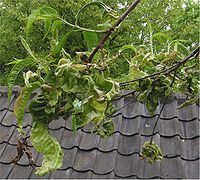Kingdom Fungi Higher classification Sac fungi | Rank Subphylum | |
 | ||
Subdivision TaphrinomycotinaO.E. Erikss. & Winka 1997 Lower classifications | ||
10 clete kurtzman saccharomycotina and taphrinomycotina progress in circumscription of genera
The Taphrinomycotina are one of three subdivisions constituting the Ascomycota (fungi that form their spores in a sac-like ascus) and is more or less synonymous with the slightly older invalid name Archiascomycetes (sometimes spelled Archaeascomycetes). Recent molecular studies suggest that the group is monophyletic and basal to the rest of the Ascomycota.
The Schizosaccharomycetes are yeasts (e.g. Schizosaccharomyces) that reproduce by fission rather than budding, unlike most other yeasts, many of which are in the subdivision Saccharomycotina.
The Taphrinomycetes are dimorphic plant parasites (e.g. Taphrina) with both a yeast state and a filamentous (hyphal) state in infected plants. They characteristically infect leaves, catkins, and branches, not roots.
The Neolectomycetes are species in a single genus, Neolecta, which are the only members of the subdivision that form fruiting bodies, and which specifically grow out of root tips. They may have a yeast state (ascospores bud in the asci).
The Pneumocystidomycetes also encompasses only one genus, Pneumocystis, one of which causes Pneumocystis pneumonia in humans. All species infect mammalian lungs and are yeasts.
None has ascogenous hyphae giving rise to the asci.
